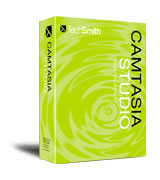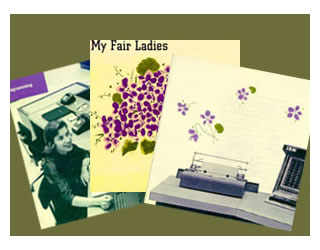
(I was strongly tempted to reference the Pussycat Dolls song and give this post the title Don’t You Wish Your Mac Did Screencasts Like the PC?. That damned song seems to have crept into every movie or trailer I’ve seen in the past week.)
You’d think that with its serious “creative cred” that someone would’ve developed a killer screencasting application for the Mac, but I agree with the folks over at 37 Signals: there just isn’t one. The 37 Signals folk are pretty hard-core Mac fans — it’s reflected in both their design aesthetic as well as the preferred platform of Ruby on Rails developers (RoR was developed by 37 Signals’ David Heinemeier Hansson) — so it’s pretty safe to assume that they’ve hunted high and low for a reasonable scrrencasting app that runs on their platform of choice.
The closest candidate is Snapz Pro, written by Ambrosia Software, creator of some really great Mac games and utilities. I use Snapz, which is probably the best screen-grabbing utility I’ve ever used as well as WireTap Pro, which is equally excellent as an audio capture tool.
The pro version of Snapz does a decent job of capturing screen movies, but therein lies the problem: there’s a difference between “capturing movies of the screen” and “producing a screencast”. When it comes to producing a screencast, the editing process tends to take up far more time than the recording prcoess, and that’s where Snapz Pro falls short. To do editing, you’ve got to go to iMovie, and to produce title cards, you’ve got to fire up your favorite image-editing software, and so on. There’s a lot of “legwork” involved. As the 37 Signals people put it:
Here’s what I’d like to see. Basic screen video capture with a few simple compression options, audio recording, caption/graphic overlay support, simple video editing (cut, duplicate, slow down, just the basics), and export to Quicktime or Flash. All wrapped up in a nice UI too, of course. The biggest downfall of the current options is editing — there’s no way to preview the screencast you just created, overlay some captions, intro and outro text, and cut out some of the dead video).
Can I get an amen? Better yet, can I get a product?
I’ll agree that using separate tools is probably the better way to go if you’re producing a film, but if you’re trying to quickly produce a screencast (or several screencasts) demonstrating a UI for your customers with voice-over narration that also lets me do a little editing, make titles and throw in some transitions, I want a tool that’s a little more monolithic, a tool that — dare I say it? — takes a more “Microsoft Office-y” approach like the 37 Signals people suggest. That tool is Camtasia Studio.
Camtasia Studio supports all sorts of output formats, from QuickTime and Windows Media to what seems to be the preferred format these days — Flash video with an integrated player, a la YouTube. Adding titles, transisitons and text captioning is easy, and there’s a pretty decent edit suite in there too. For the videos you output in Flash, there’s the option of adding interactive “call-outs” (highlighted areas of the movie) and “hot spots” which when clicked take the user to a predetermined point in the movie or a web page. I’ve already used it to create a couple of screencasts for use by Tucows’ sales team, and they love the results. I’ve already committed to creating some screencast tutorials for end users for some of our Tucows services. And yes, they’ve got a version that runs under Vista — I run it on “The Taint”, the Acer laptop sent to me as part of a Vista promo. Call me a happy (and completely unsolicited) user of Camtasia Studio.
So c’mon, Mac developers — where’s the Mac equivalent of Camtasia?
![]() A number of my (ahem) file sharing enthisiast friends tend to favour the RAR compression format over ZIP, since the “word on the street” is that it makes for smaller files. This is particularly handy for all sorts of uses, from creating archives of version-control repositories of your code to say, passing around copies of the leaked Arcade Fire album, Neon Bible.
A number of my (ahem) file sharing enthisiast friends tend to favour the RAR compression format over ZIP, since the “word on the street” is that it makes for smaller files. This is particularly handy for all sorts of uses, from creating archives of version-control repositories of your code to say, passing around copies of the leaked Arcade Fire album, Neon Bible.

 Back in July 2003, someone who read the Wired article titled
Back in July 2003, someone who read the Wired article titled  A lot of startups today are creating software that doesn’t target a specific operating system. They’re developing software to run on the internet; on stacks of free and open software (ie, LAMP), and using browsers’ HTML and JavaScript rendering capabilities to be the client side of their applications. In another era, they might have been developing Windows software, writing to the Windows API, and delivering their apps as Windows binaries. So what’s Microsoft to do to keep developers focused on platforms they control? Robert “
A lot of startups today are creating software that doesn’t target a specific operating system. They’re developing software to run on the internet; on stacks of free and open software (ie, LAMP), and using browsers’ HTML and JavaScript rendering capabilities to be the client side of their applications. In another era, they might have been developing Windows software, writing to the Windows API, and delivering their apps as Windows binaries. So what’s Microsoft to do to keep developers focused on platforms they control? Robert “

 The Google Apps for Your Domain (GAYD) brand may be no more, but its successor,
The Google Apps for Your Domain (GAYD) brand may be no more, but its successor,  Despite the coverage, this is by no means a battle of equals. Yet. Microsoft’s Office suite is more complete (it includes a local database and presentation program, and is tightly integrated with Microsoft’s business graphics and project management tools), more powerful, works offline, and is more entrenched (a scary amount of people’s work involves Visual Basic for Applications scripts). Those strengths, however, are also Google’s opening.
Despite the coverage, this is by no means a battle of equals. Yet. Microsoft’s Office suite is more complete (it includes a local database and presentation program, and is tightly integrated with Microsoft’s business graphics and project management tools), more powerful, works offline, and is more entrenched (a scary amount of people’s work involves Visual Basic for Applications scripts). Those strengths, however, are also Google’s opening.